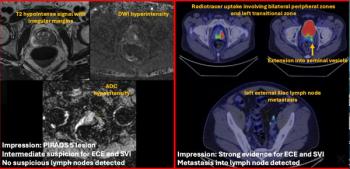
New online service grades imaging centers
With a click of a mouse, referring physicians in selected states can get an instant evaluation of imaging centers competing for their business. OptiNet, a new web-based tool, lets physicians quickly compare quality and cost of imaging services at centers and hospitals within 30 miles of a patient’s address. It assigns a letter grade for each modality offered, along with an average cost per exam.
With a click of a mouse, referring physicians in selected states can get an instant evaluation of imaging centers competing for their business. OptiNet, a new web-based tool, lets physicians quickly compare quality and cost of imaging services at centers and hospitals within 30 miles of a patient's address. It assigns a letter grade for each modality offered, along with an average cost per exam.
OptiNet was developed by American Imaging Management, a subsidiary of Anthem Blue Cross and Blue Shield's parent company (WellPoint). The evaluation system is designed to help doctors advise patients with Blue Cross and Blue Shield health insurance about advanced imaging services - CT, MRI, nuclear medicine, and PET. Access to the site is limited to referring physicians.
Imaging services receive an A, B, or C grade for each modality based on criteria such as staff credentials, quality of equipment, site accreditation, patient accessibility, hours of operation, policies, and procedures. Cost and quality scores are shown in two columns, sorted first by quality and then in ascending order by cost. For cases in which multiple modalities are ordered (CT and MR, for example), quality scores are averaged and the costs summed.
"They score each modality," said Christine Keefe, chief financial officer with Metro Imaging, a diagnostic imaging provider in St. Louis that which participates in OptiNet. "For example, with CT, they are looking at the age of the equipment, the number of slices, the accreditation, lead time, the use of a certified technology, and staffing. Similar questions apply to MR: the strength of the magnet, the age of the equipment."
Doctors accessing OptiNet, however, do not see this level of detail. They view a letter grade but not the criteria on which it is based. Deanne Blume, chief operating officer at Metro Imaging, sees this as one of the drawbacks with the system.
While both she and Keefe consider OptiNet a potentially useful service that may encourage imaging centers to stay up to date and accredited, they noted other features that need tweaking.
"If your equipment is over three years old, you get downgraded," Blume said. "I don't know any medical facility that doesn't have at least a five-year lease on medical equipment."
Keefe added that Metro Imaging's CT received a C grade because it was in the process of being accredited by the American College of Radiology.
"The program does not recognize an application in process for accreditation," Keefe said.
She pointed out that Metro Imaging lost points because of the limitations of its two-year-old six-slice CT Siemens SOMATOM Emotion 6. The scanner works well for many outpatient imaging studies - abdomen and pelvis, for example - but it is not fast enough to handle cardiac imaging.
Paul Danao, vice president for business development at American Imaging Management, said that OptiNet has been improving its system based on suggestions such as these.
"We've gotten some really good recommendations from providers and made some adjustments," Danao said. "Overall, I think providers see OptiNet as a movement in the right direction in terms of offering more information on what they're doing. Providers who have really good staffing, good equipment want to be recognized for that."
Since August, OptiNet has been introduced in five states: Indiana, Kentucky, Ohio, Missouri, and Wisconsin. WellPoint plans to expand the reach of OptiNet to other states in the near future, according to spokesperson Jill Becher.
For more information from the Diagnostic Imaging:
Newsletter
Stay at the forefront of radiology with the Diagnostic Imaging newsletter, delivering the latest news, clinical insights, and imaging advancements for today’s radiologists.




























